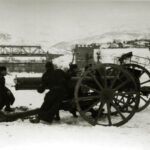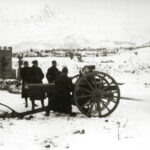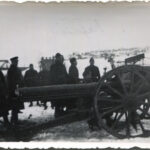- Russian Protective Corps WW2 Guide books, battlefield maps and virtual tours
Artillery. Not wanting to make the Russian Corps combat-ready, the German command, despite the presence in its ranks of a large cadre of experienced artillerymen, did not foresee the formation of divisional artillery, and the supply of materiel was carried out “in an economic way, without expenses from the treasury.”
The resulting Schneider guns, which were not bad in a field war, were not suitable in mountainous conditions, and all the property was in a deplorable state and required major repairs on their own, using improvised material. The necessary instruments were not given, not even shooting tables, and everything was worked out in practice. There were no ammunition depots under the Corps, and the loss of shells was almost exclusively replenished with what was taken from the enemy.
The guns of PAK platoons are good against machine-gun nests and armored vehicles, but, of course, they were not suitable for fighting tanks (by Gulevich S.)
Russian Protective Corps PAK platoons formation
(Regimental platoons of PAK anti-tank guns)
One of the stages in the gradual improvement of the Corps’ weapons was the acquisition of anti-tank guns. In early July 1942, the regiments received an order to be allocated a platoon, according to the specified states, and sent to Corps headquarters for training. Due to the fact that this new type of weapon developed after the First World War, there were no specialists in this field among the Corps command staff; therefore the training had to be carried out by German instructors. Since all the tactics of the P.T.O. (anti-tank defense) is based on speed, which requires energy and significant physical exertion from the personnel, all rank and file and command personnel were to be staffed only by youth, as an exception to the usually applied principle of selecting the appropriate candidate in order of seniority of ranks.
As a squad commander in the 1st cadet company of the 1st regiment, on the day I received the order, I went to Belgrade to attend the graduation ceremony of General Golovin’s Higher Military Scientific Courses, which I was graduating from. Therefore, it was a complete surprise for me when General Shteifon, who was present at the event, congratulating me on completing the course, said that he was glad to have the opportunity to appoint me to the officer vacancy as commander of the PAK platoon of the 1st regiment.
The next day, having appeared in Loznitsa at the regimental headquarters, I was summoned to General Zborovsky.
“Your platoon has already been assembled and should leave for Belgrade tomorrow,” the regiment commander greeted me. – In order not to tear away many young people from the cadet companies while they have not yet completed the training program, your platoon is staffed by young people from the disbanded scooter team of the regimental headquarters. These are good young people, but they have been severely disbanded here at headquarters. You will have to teach them discipline. In this you can count on my full support,” the general smiled, “you will only receive cadets for a start.” Elderly Cossacks, experienced in handling horses, are assigned to you as riders.
The following were appointed to non-commissioned officer positions as squad commanders: second lieutenant Vl. Veter (my deputy) from the Guards hundred, the 2nd cadet company of sword belts – cadet Gontarev and the 1st cadet company of sword belts – cadet Schaefer Georgy. In the list of the platoon, I was happy to see B. Schaefer, O. Rodzianko, Pinotsi and several other familiar names of the cadets of the 1st company and the 2nd company of cadet Balabin.
I didn’t know the young people from the scooter team, but most of them made a good impression, especially the big ones like Reshchikov, Savich and the Alenov brothers.
By July 10, the platoons assigned from the 4 regiments arrived at Banitsa. The platoon of the 2nd regiment was commanded by Captain Somov, the 3rd by Second Lieutenant Lepekhin and the 4th by Lieutenant Colonel Osipov. The young age requirement for rank and file was fulfilled by all regiments; as for the command staff, it was entirely only the 1st and 3rd regiments. Older than the others was the commander of the 4th regiment, where there were few young people at all. On the very first day we met our teacher – a young but already experienced officer, Oberleutnant Von der Busch. The black tankman’s uniform with pink piping “Panzereger” (tank destroyers) and the Iron Cross of the 1st degree immediately inspired respect for him. Strict and demanding, but always correct and friendly, he soon won everyone’s love. A gentleman from head to toe and a convinced military man, he belonged to the noble type of career German officer, uncorrupted by either party demagoguery or Prussian arrogance. Several German sergeants and non-commissioned officers were seconded to help him.
The training program was developed with German punctuality and utmost efficiency in the use of time, and we were immediately put to work. Our guns stood on the concrete platform in front of the large workshop. These were 37 mm Skoda semi-automatic anti-tank guns with sliding frames. Miniature, they seemed like toys, but the long barrels indicated good ballistic qualities. Each gun had two one-horse gigs, which served as a limber and a charging box. One gun was served by one squad: a squad commander, 5 gun crew numbers and 2 riders (one per gig). In the combat position, the gun was moved by the strength of the numbers of the gun crew.
Designed to fight tanks, the gun fired only direct fire (sighting range 1500 m, actual fire 700 m) and therefore could only operate from an open position. The steel shield protected the servants only from rifle and machine-gun fire. Therefore, our main tactical principles had to be camouflage, skillful use of terrain and speed. The speed of entering a position, the speed of hitting a target and the speed of moving to cover to reach a new position. When repelling a surprise attack by tanks, everything depended on the speed of transferring the gun from the traveling position to the combat position and the speed and accuracy of fire. Oberleutnant Von der Busch began to teach us all this.
Every day, after a lecture on tactics in the form of a concrete example, we went out into the area and solved a similar problem, at the same time practically becoming familiar with the methods and skills of overcoming various local obstacles. Soaked up and tired, we returned to the barracks for lunch and after a short rest we again went out for training at the guns, aiming exercises, or again a task on the ground.
The entire composition of our platoons worked with passion and effort; Every day we became more and more comfortable with our guns and became imbued with love for our new type of weapon.
The first shooting gave a brilliant result. According to the conditions of the exercise, it was required to make three hits on the target out of five projectiles. In my platoon, the entire command staff, all the gunners and more than half of the rest of the personnel had all five hits, and there was not a single one who did not fulfill the quota. Approximately the same results were observed in other platoons.
The German non-commissioned officers examined the targets in surprise, the lieutenant smiled contentedly, and our youth beamed with joy and, polishing the guns to a shine after shooting, almost kissed them. We began to trust our guns and our strength. From our lecturer we knew that the 37 caliber was no longer sufficient against new modern tanks and that on the Eastern Front the Germans had already switched to guns of larger calibers, but for the conditions of that time in the Balkans it was still quite suitable.
Time flew by unnoticed in the intense and interesting work. Tactical shooting was also successful. The end of the course was marked by a one-way maneuver, which was supposed to show how successfully we had mastered the course.
Having deployed at the starting line for the offensive, one and a half kilometers from the “enemy-occupied” height (at which the Corps commander and headquarters were located), our anti-tank platoons had to secretly take positions 400 m from the enemy by the specified date to support the attack. The maneuver was executed well. Observers standing on the heights saw individual guns appearing here and there and quickly disappearing again; when the all clear signal sounded and the camouflage was dropped, all four platoons emerged from positions that covered the height on three sides in a wide arc at a distance of 300-400 m.
After a brief analysis of the maneuver, the Corps commander expressed gratitude to our teacher and the personnel of our platoons. A cabinet photographer captured this moment. Lined up in a common front across a wide meadow, 12 gun teams made an impressive impression.
As a reward, we all received a week’s leave, after which we gathered again at Banitsa to receive the guns, horses and all standard equipment and property. In addition to 3 gun teams and 3 charging boxes, the platoon had a light machine gun link for self-defense and a utility cart with a supply of fodder, which included a blacksmith and a gunsmith. In view of the decision taken by that time to disband the 4th Regiment, their platoon was left at Corps headquarters; the rest went to their regiments. At the Topchider railway station, my platoon was loaded onto the train. The guns and gigs were secured on open platforms; The combat crew was located right next to the cannons, and the riders with horses were in a closed carriage behind. Oberleutnant Von der Busch and his non-commissioned officers came to see us off. The last handshakes and the train started moving.
In the evening we arrived at the Ruma junction station, where we were detained because… The partisans cut off the route between Ruma and the next station. We spent the whole night in combat readiness, but there was no attack, just like the next morning, when our train moved forward with precautions. To the deep regret of the youth, who were eager to test the effect of our high explosive grenades in practice, the partisans disappeared.
Late in the evening we were in Loznitsa. At the station we were met by the regimental adjutant, Colonel Krasnov.
“You will introduce yourself to the regiment commander tomorrow morning,” he told me, “and now lead the platoon to the commandant’s office building, where you have been assigned a room.”
Having appeared to the commandant, Colonel Gulyga, we immediately felt that we had returned home; everything was carefully prepared for our arrival. In the platoon quarters there were already beds with mattresses stuffed with fresh straw, a hot dinner was waiting for us all, and even the orderlies at our guns were assigned to the commandant’s team for that night.
In the morning, having reported to the regiment commander about my arrival, I reported that the platoon needed one and a half to two months of intensive training in order to fully assimilate everything that we were taught at the course.
‘ – Go ahead, friend, – General Zborovsky approved, – and contact me if you need anything.
First of all, we set about setting up the new location. In the back yard of the commandant’s office there was a large canopy, under which guns and gigs could be conveniently placed, but in the middle of the yard there was a large puddle. Armed with picks and shovels, we built a brick-covered drainage channel, leveled and filled the yard with sand, and made a plank floor under the guns and gigs. By evening the courtyard took on the appearance of a real barracks courtyard. Having started my studies the next day, I soon encountered three big difficulties. Our one-horse gigs were good on flat terrain; In order to pull a gig with a gun along steep mountain roads and paths, exceptionally strong horses were required. The horse of the first gun, Eagle, was such, but the others were struggling.
“Yes, you don’t need horses, but lions,” agreed the regiment commander, who observed our training, and on his orders, the horses of the 2nd and 3rd guns were replaced from other units of the regiment with the same “beasts.” In addition, I received several bags of oats from the regimental reserves for additional nutrition for these horses. The horses began to gain weight, but the people began to lose weight. Due to intense physical work in the fresh air, the youth had a voracious appetite, and our diet was rather meager. The regiment commander allowed the platoon to have its own kitchen and be content separately. My youth became cheerful; I received the moral right to demand more effort from them during classes. But there was no need to demand; As for classes and service, they pulled themselves together and pulled each other up. I had to impose penalties only for disciplinary offenses outside of service. And “at first, in the evenings, someone would often “dry his pants” while standing with a rifle. The main burden of educational work lay on the squad commanders, and in them I had faithful assistants who worked not out of fear, but out of conscience. Soon after returning to belt regiment cadet Gontarev submitted a report on transfer to the PAK platoon at the Corps headquarters, for joint service with his father (General Gontarev was the chief of staff of the Corps at that time).At my request, cadet cadet Pustovalov (1st cadet company) – an excellent combat officer who knew how to hold his subordinates firmly in the hands without unnecessary severity.
The third problem was the question of how to train in shooting without wasting shells, because… The kit given to us was allowed to be used only in a combat situation. The learned artilleryman, Colonel Mionchinsky, worked in the regimental weapons workshop. According to his instructions, three devices were made, with the help of which a rifle barrel with a chamber was inserted into the bore of the gun, exactly along its axis. Due to the fact that the trajectory of the rifle during the first 100 m coincided with the trajectory of the gun, this made it possible to fire up to this distance, aiming with the gun and firing with a rifle cartridge.
The end of August, September and October were spent in intensive training. In the vicinity of Loznitsa there is not a single peak, not a single mountain path, where our guns would not pass, performing one or another tactical task. At the shooting range set up near our location, shots were heard almost every day. The youth worked with enthusiasm, competing with each other in clarity and speed. “Our weapon must be first!” – was the motto of each department. This gave excellent results: transferring the gun from the traveling position to the combat position took only 13-15 seconds instead of 18-20, which was the norm; by the 25-30th second the gun had time to fire five shots at different targets.
In October we passed a practical exam, taking part in an expedition together with the Guards Hundred, under the leadership of the regiment commander, against the partisans who, according to intelligence information, were accumulating in the mountains northeast of Moikovichi.
There was no enemy there, so we were not able to shoot again, but the four-hour night march along unfamiliar mountain paths was a serious test of the platoon’s maneuverability. Both people and horses withstood it. The two-month training was not in vain. The platoon was ready to carry out combat missions. (By W. Granitow)
- Bridge and bunker near Jošanička Banja resort, B53
- Artillery firing, B54
- close-up view of the weapon, B51



